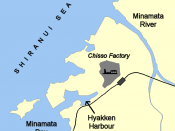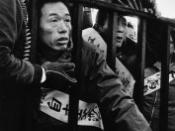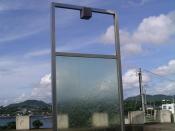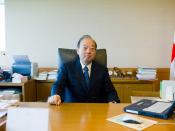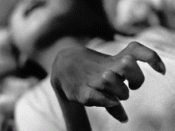The Minimata disease was an epidemic in Japan. The disease, caused by the consumption of mercury, killed many people and damaged many lives. Its sufferers and the terms of their compensation will be discussed in this essay.
Many solutions were sought to compensate the victims while not bankrupting Chisso. The first wave of compensations, settled in 1959, could not be maintained as new cases of Minamata disease began to appear. These victims and their families were not included in the original settlement with Chisso and therefore, did not receive the same compensation as those diagnosed before the original solution. So the newly diagnosed families began the quest to receive comparable compensation for their disabilities. One group chose to sue Chisso and therefore go to trial for their compensation. Another group sought direction negotiations with the executives of Chisso.
These direct negotiations in Tokyo were exhausting. On December 8, Kawamoto, a leader in the direct negotiations group, began by asking Shimada, a Chisso executive, to pledge in their blood to come to an agreement and treat each other as human beings.
Shimada refused. The negotiations lasted through much of the night, ending with Shimada collapsing and being taken to the hospital. The Minamata patients were told to go home, and when Shimada was able to negotiate again, he would do so in Minamata. However, the patients remained in the Chisso headquarters. By December 25, only two patients remained in Tokyo, Kawamoto and Sato. Chisso Executive Director Kuga, approached them and asked for them to take some money and buy tickets back to Minamata. Kawamoto and Sato refused unless Chisso agreed to direct negotiations. They were thrown out to the unsightly tented settlement outside of the building.
After this, protests and speeches by the patients took place outside of the Chisso office building. Media coverage was wide spread and many journalists took the side of the Minamata victims. Patients were shown in wheelchairs at the protests and in newspapers. However, the stalemate remained.
Patients and sympathizers marched on the downtown offices of Chisso and attempted to march as far as the presidentÃÂs office. They were met with iron bars blocking the door to the Chisso floor of the Tokyo Building. The patients used the bars to their advantages by building memorials to the people who had already died of Minamata disease.
Because of the mass of media coverage, the Japanese Communist and Socialist parties began to more openly support the sufferers of Minamata disease along with the Sohoyo labor federation. The attention of the media and political party officials allowed Minamata disease to become a widely known dilemma in Japan and because the minority population of Minamata disease sufferers then had a voice, it then allowed Japanese democracy to develop to a new level. Also, due to this open support by opposing parties, and the call from the labor union for Chisso to negotiate, the Japanese government stepped into action by the Director General of the Environmental Agency (Oishi Buichi) asking to be allowed to mediate the negotiations.
Also around this time, Governor Sawada Issei came to Tokyo to help in overcoming the impasse of negotiations. Sawada and Oishi both met with the patients, Kawamoto and Sato, and also with Shimada, who had returned from the hospital. Both parties agreed to mediate negotiations through Sawada and Oishi.
As the negotiations began, the patients opposed a settlement mirroring that of the first solution. They not only wanted equal and sufficient compensation, but also for Chisso to publicly accept responsibility for the Minamata disease.
During these negotiations and also talks of a compensation advance, 29 more patients were diagnosed with Minamata disease. These newest patients were more cooperative with Chisso and agreed to accept a low compensation of $570 each. This caused a split between the newly diagnosed families. It also took away much of the leverage the direct negotiation group had and gave Chisso an advantage. The division between the Tokyo group and the Minamata group brought up hard feelings. Those in Minamata had continued to work, while the protestors in Tokyo had received financial support from backers in Tokyo. Many of those in Minamata were facing continued discrimination, but also were being threatened of losing their jobs if they continued with the negotiations. Only four people ultimately decided to drop the negotiations.
The patients reduced their demands to close to what the first settlement between Chisso and the original Minamata victims had been. However, Chisso still refused because of the lack of a ranking system for the severity of illness. Then the negotiations were officially suspended, due to ChissoÃÂs unwavering stance.
Finally, the trial verdict came down in favor of the patients. The District Court found Chisso guilty of corporate negligence and ordered Chisso to pay $66,000 for each patient who had already died, between $59,000 and $66,000 for surviving patients, coming to a total of $3.44 million.
This gave the direct negotiations patients grounds to reach agreements. After days of agreements, Chisso agreed to pay $66,000 for deceased patients who were included in the group of newly diagnosed patients. This opened the door for the other newly diagnosed patients to be included in the trial settlement. Finally, on July 9, 1973, through the work of the new Environment Agency Director Miki, an agreement was reached. This proposal included the compensations based on ranking severity of symptoms, but also payments to the patients per year to cover living expenses, and payment of all medical expenses. The government also provides medical examinations for people living in the affected area. These compensations and actions are considered inadequate by many.
Bibliography:1. en.wikipedia.org/wiki/Minamata_disease2. lists.essential.org/1996/dioxin-l/msg00534.html3. www.unu.edu/unupress/unupbooks/uu35ie/uu35ie0c.htm
